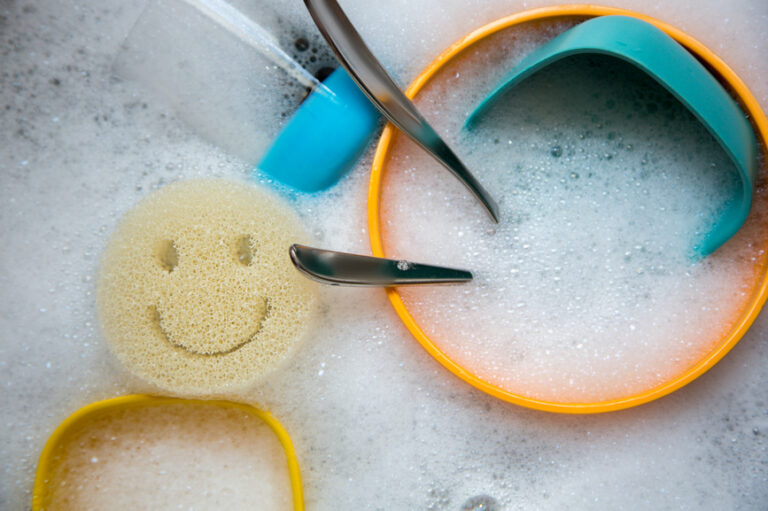If it's hard to imagine a dirtier place than a worn-out toilet, Trevor Craig, food safety expert and corporate director of technical training and consulting at Microvac Laboratories, suggests taking a closer microscopic look at what lives in your kitchen sink, sponges and dish towels.
What do you find? A ton of bacteria. Dare we say it? More bacteria than you'll find on a toilet bowl. That's pretty gross. Read on to find out what food safety experts say are the top five dirtiest items in your kitchen. Not to scare you, but to help you focus your cleaning efforts in the right places in your home. That way, you'll sleep better at night and reduce the risk of food poisoning every time you cook.
The 5 dirtiest kitchen items, according to food safety experts
Not to sound any alarm bells, but according to Craig, the top five dirtiest items in the kitchen are (in no particular order): the kitchen sink, kitchen sponge, dish or drying towels, cutting board, and refrigerator (and door handles.) “These are all high-touch, high-touch areas that don't get cleaned as often as they should,” Craig says.
First, sponges, dish towels, and cutting boards come into physical contact with a lot of food, posing a high risk of exposure to bacteria and therefore a high risk of contamination, Craig explains. do not have If not properly cleaned, they become the perfect environment for the spread (and growth) of bacteria, especially with frequent use.
Refrigerators and their door handles are also common areas of contamination due to the high traffic in your kitchen. The good news is that fridges aren't at high risk for bacteria growth. “I think these spaces are a little lower risk because they don't have as much moisture or food for bacteria, but that doesn't mean they're not places where bacteria can grow,” says Craig.
But these five dirty kitchen items aren't the only ones that are susceptible to germs. Germs and germs can easily spread from these items to other areas of your kitchen, including countertops, tables, and other kitchen utensils. “You may not realize how often you touch these spaces when you're in the kitchen, whether you're cooking or not, which allows germs to be easily transmitted,” says Craig.
The dirtiest thing in the kitchen
Of the top five dirtiest kitchen items, Craig says kitchen sponges come in at number one. “To me, the dirtiest would be the sponge, because it stays wet and is more likely to have food particles on it, which is what bacteria needs to thrive,” he says. Ironic, right? clean Washing dishes, pots, and pans may actually be making things worse: “We use sponges to 'clean', but if we're not careful, things can easily get moved around and contaminate the whole kitchen, not to mention our hands,” explains Craig. Plus, the longer you use a sponge, the higher the bacteria levels can become.
4 ways to reduce the risk of contamination
1. Disinfect your workspace frequently
Bacteria and germs are all around us, but Craig says good hygiene is the best way to minimise the risk of foodborne illness in the kitchen. “Wash and change items like sponges and dish towels frequently – dish towels can easily be thrown out in your normal wash cycle, and sponges are cheap and readily available,” Craig says. In Craig's ideal world, people would wash these items at least once a day, and preferably more, especially after cooking.
2. Be careful what you touch
From a food safety perspective, Craig also urges people to be mindful of how they move around in the kitchen. “A big part of food safety is thinking about what you're doing when you're in the kitchen. How often do you handle food and then touch other surfaces? It's easy to miss that and suddenly touch another surface and transfer dangerous germs from one place to another,” he says.
3. Keep cleaning supplies close at hand
The goal is to avoid cross-contamination as much as possible. Craig recommends keeping cleaning supplies close at hand. “When you have to stop and look for something, [it’s proof] “We're not using it to its full potential,” he says.
4. Avoid cross-contamination
When cooking, Craig reiterates the importance of keeping your workspace as clean as possible. That means washing your hands and surfaces frequently when handling different foods and utensils, especially when switching between tasks. “The same concept applies to cooking. If you're in the kitchen and you forget something or need something, it's easy to open the door or cabinet and forget to wash your hands. Be prepared and think about what you're going to do before you start cooking to avoid making careless mistakes,” says Craig.
What happens when you come into contact with these dirty kitchen items?
The best case scenario is that nothing happens. But if dangerous bacteria are present and in high quantities, there could be worse effects, like contracting or spreading food poisoning. “It's easy to transfer bacteria to and from those places, and if you're not careful, you could transfer those bacteria to your face, mouth, or food,” he says. This can have life-threatening consequences. Symptoms can range from nausea, diarrhea, cramps, bloating, and spasms to more painful, costly, and potentially life-changing illnesses.
A final word of advice: Craig urges people not to take kitchen cleaning lightly. “People often say things like, 'I've never had a problem in my whole life,' but that's just not true. You've probably experienced stomach problems at some point. Stomach problems are in the top five reasons for hospitalization, but only when it's really serious,” he says. “It's easy to say it's no big deal until you're actually suffering from it,” Craig stresses. The moral of the story is to dispose of your dirty sponge as soon as possible.


